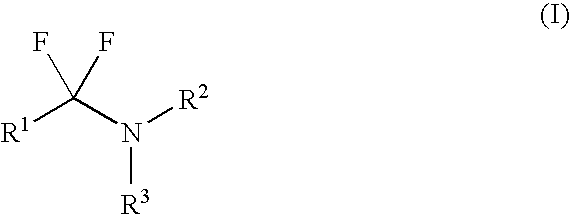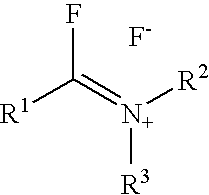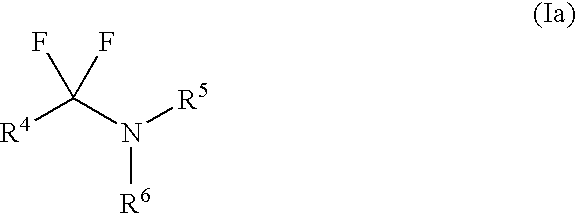Fluorinating reagents and their preparation
a technology of fluorinating reagents and reagents, which is applied in the preparation of halogenated hydrocarbons, amino compounds, biocides, etc., can solve the problems of sulphur tetrafluoride, the inability to apply reagents in a wide range of applications, and the inability to meet the requirements of extensive safety measures
- Summary
- Abstract
- Description
- Claims
- Application Information
AI Technical Summary
Problems solved by technology
Method used
Image
Examples
example 1
Preparation of 1,1-dichloro-N,N-2,2-tetramethyl-1-propanamine
[0094] 27.8 g (210 mmol) of N,N-dimethylpivalamide and 250 ml of tert-butyl methyl ether are initially charged at 20° C. under a protective gas atmosphere in a 3-necked flask equipped with precision glass stirrer. 27.7 g (220 mmol) of oxalyl chloride are added dropwise to this reaction mixture, and a colourless solid is deposited during the addition. On completion of addition, the mixture is stirred until the end of gas evolution (approx. 2 h) and, to complete the reaction, the mixture is heated to 40° C. for 0.5 h. After all volatile constituents have been removed in high vacuum, 1,1-dichloro-N,N-2,2-tetramethyl-1-propanamine is obtained as a colourless, hydrolysis-sensitive solid.
[0095] Yield: 38.0 g (207 mmol; 96%)
[0096]1H NMR (CDCl3): 0.99 (s broad, 9H, t-Bu-H), 3.46 (s, 6H, N(CH3)2).
[0097]13C NMR (CDCl3): 28.1 (CH3, 3C, t-Bu-CH3), 29.5 (quat. C, 1C, t-Bu-C), 44.8 (CH3, 1C, NCH3), 51.1 (CH3, 1C, NCH3), 186.6 (quat....
example 2
Preparation of N,N-diethyl-α,α-dichloro-3-pyridylmethanamine
[0098] 18.5 g (104 mmol) of N,N-diethylnicotinamide and 150 ml of tert-butyl methyl ether are initially charged at 20° C. under a protective gas atmosphere in a 3-necked flask equipped with a precision glass stirrer. 13.5 g (106 mmol) of oxalyl chloride are added dropwise to this reaction mixture, and a colourless solid is deposited during the addition. On completion of addition, the mixture is stirred to 20° C. for 1 h and, to complete the reaction, is heated to reflux for a further 4 h. After cooling to 20° C., the solvent is removed under water jet vacuum, and the remaining residue is washed with a little cold Et2O. After drying in high vacuum, N,N-diethyl-α,α-dichloro-3-pyridylmethanamine is obtained as a slightly yellow solid (m.p.: 113-115° C.).
[0099] Yield: 22.9 g (98.8 mmol; 95%)
[0100]1H NMR (CDCl3): 1.16 (s, 6H, —CH3), 3.90 (s, 4H, —CH2), 7.21 (s, 1H, arom.-H 8.37 (s, 2H, arom.-H), 8.91 (s, 1H, arom.-H) ppm
[010...
example 1a
Preparation of 1,1-Difluoro-N,N-2,2-tetramethyl-1-propanamine 1a
[0104] 17.8 g (424 mmol) of sodium fluoride are added under a protective gas atmosphere to a suspension of 19.5 g (107 mmol) of 1,1-dichloro-N,N-2,2-tetramethyl-1-propanamine from Example 1 in 75 ml of dimethylimidazolidinone and stirred at 20° C. for 25 h. The inorganic salts are filtered off under a protective gas atmosphere and washed twice with 20 ml of dimethylimidazolidinone each time. The crude product is condensed over under high vacuum from the reaction solution into a receiver cooled to −78° C. and, after subsequent fractional distillation, under reduced pressure (b.p.: 62° C. / 55 mbar), affords 1,1-difluoro-N,N-2,2-tetramethyl-1-propanamine as a slightly yellow liquid.
[0105] Yield: 13.6 g (90 mmol; 84%)
[0106]1H NMR (CDCl3): 1.00 (s broad, 9H, t-Bu-H), 2.26 (t, 6H, 4JHF=1.95 Hz, N(CH3)2) ppm.
[0107]13C NMR (C6D6): 25.7 (s, CH3, 3C, t-Bu-CH3), 38.3 (t, CH3, 3JCF=6.03 Hz, N(CH3)2), 40.0 (t, quat. C, 1C, 2JCF=2...
PUM
| Property | Measurement | Unit |
|---|---|---|
| Molar ratio | aaaaa | aaaaa |
| Reactivity | aaaaa | aaaaa |
Abstract
Description
Claims
Application Information
 Login to View More
Login to View More - R&D
- Intellectual Property
- Life Sciences
- Materials
- Tech Scout
- Unparalleled Data Quality
- Higher Quality Content
- 60% Fewer Hallucinations
Browse by: Latest US Patents, China's latest patents, Technical Efficacy Thesaurus, Application Domain, Technology Topic, Popular Technical Reports.
© 2025 PatSnap. All rights reserved.Legal|Privacy policy|Modern Slavery Act Transparency Statement|Sitemap|About US| Contact US: help@patsnap.com



